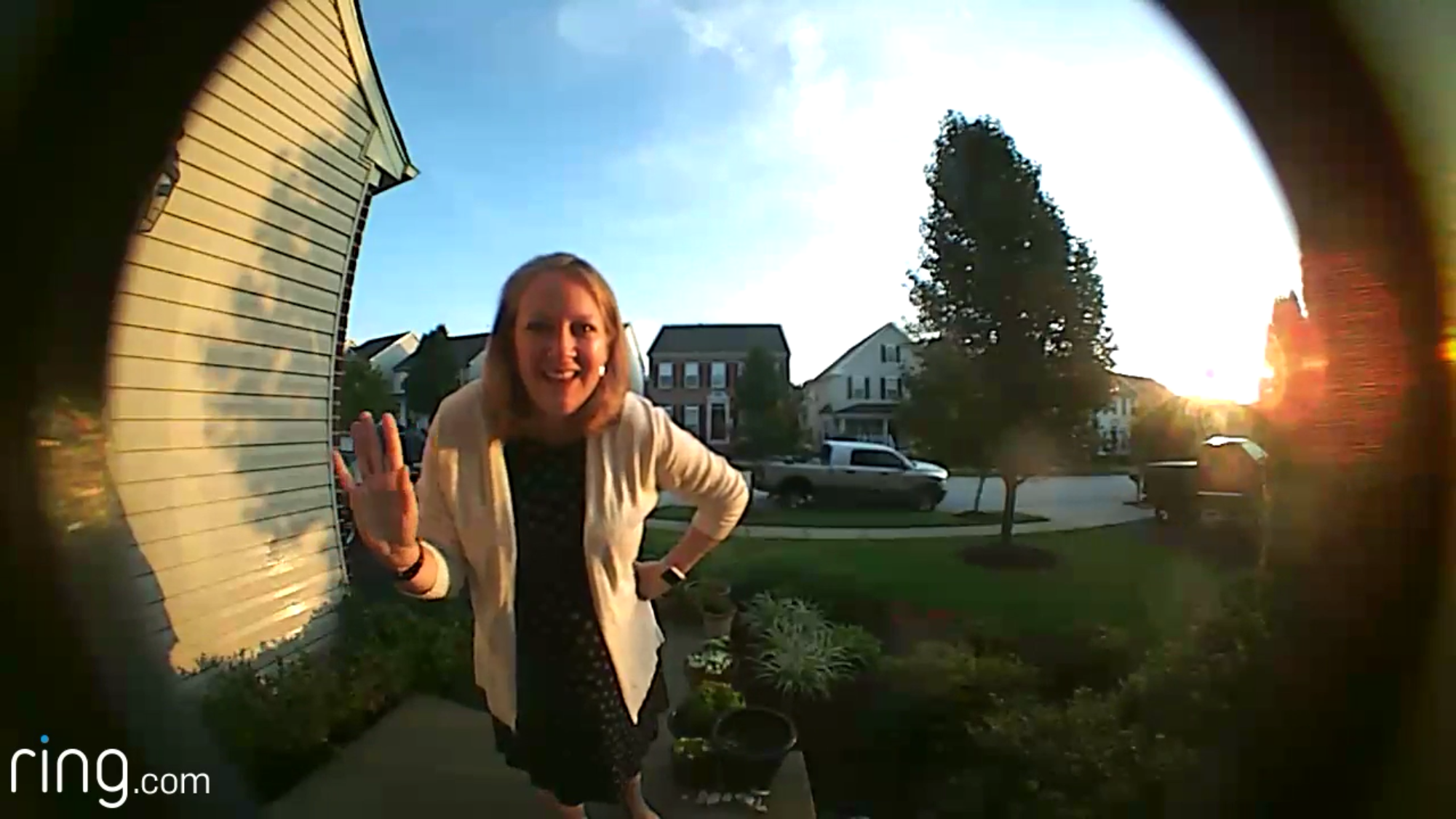Over the past four years, my husband and I have installed several “smart home” or “Internet of Things” (IoT) devices throughout our home, to help in many facets of life. Some save us money on monthly utility bills, some provide additional security, and some just for fun. Learn about the particular devices that we’ve deployed in this post. And, as always … your comments are more than welcome at the bottom of this write-up. Looking forward to hearing what devices you love or loathe.
Shortcut Menu:
- Audio
- Heating / Cooling
- Lights / Outlets
- Phone
- TV
- Safety & Security
- Yard / Gardening
- Online Applications That Tie It All Together
Audio
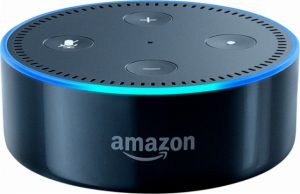 We were hit-or-miss on the need for having a device that listens to everything in the house at all times. To try out the technology, my husband opted to buy an Echo Dot for his “man cave,” because he caught a good deal while they were on sale during Amazon Prime Day 2017. He has found it ties in nicely with some of the other Internet of Things (IoT) smart devices we already have throughout our home. Though he enjoys using it, we still don’t have a need for a wide-spread setup. It works nicely as a music playing device, voice control of the man cave entertainment unit when paired with the Logitech Harmony hub (reviewed below, under “TV” subhead), controlling the TP-Link Smart Plugs (reviewed below, under “Lights / Outlets” subhead), and interfacing with Samsung SmartThings hub (reviewed below, under “Safety & Security” subhead) to control products connected to that. One of the more fun things to do is change the default name command from “Alexa” to something else of your choosing. He, being a self-proclaimed nerd, changed ours to “Computer” to simulate the system they use in the StarTrek series.
We were hit-or-miss on the need for having a device that listens to everything in the house at all times. To try out the technology, my husband opted to buy an Echo Dot for his “man cave,” because he caught a good deal while they were on sale during Amazon Prime Day 2017. He has found it ties in nicely with some of the other Internet of Things (IoT) smart devices we already have throughout our home. Though he enjoys using it, we still don’t have a need for a wide-spread setup. It works nicely as a music playing device, voice control of the man cave entertainment unit when paired with the Logitech Harmony hub (reviewed below, under “TV” subhead), controlling the TP-Link Smart Plugs (reviewed below, under “Lights / Outlets” subhead), and interfacing with Samsung SmartThings hub (reviewed below, under “Safety & Security” subhead) to control products connected to that. One of the more fun things to do is change the default name command from “Alexa” to something else of your choosing. He, being a self-proclaimed nerd, changed ours to “Computer” to simulate the system they use in the StarTrek series.
We also have friends that have Echo Dots in every major area in the house, with a primary Echo device in the heart of the home (i.e., kitchen). This allows all family members to listen to music etc. — then when a parent needs everyone’s attention, they can interrupt by using it as an intercom system.
Of Note:
These are smart home devices we are aware of and fans of, based on media reports, but do not currently own or use.
Heating / Cooling
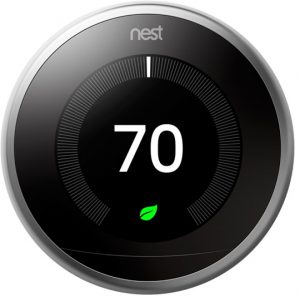 We definitely knew we wanted a smart thermostat for our home, that would learn our patterns, save us energy consumption, and reduce our monthly energy bill. We leaned towards the Nest device for its easy-to-use and refined interface, as well as its smart device application. Regardless of where you are in the home, just pull up the application on your smart device to change the temperature and settings. I can even change the temperature to start pre-cooling or pre-heating the house when I know I’m en route. During the recent solar eclipse, Nest pushed out an opt-in message for “Solar Rush Hour” to pre-cool your home and reduce consumption during the peak of the eclipse (when non-solar-powered utility plants would be taxed due to lack of sunlight). For more on how we cut our energy bill, see Harness the Power of the Sun: Install Residential Solar.
We definitely knew we wanted a smart thermostat for our home, that would learn our patterns, save us energy consumption, and reduce our monthly energy bill. We leaned towards the Nest device for its easy-to-use and refined interface, as well as its smart device application. Regardless of where you are in the home, just pull up the application on your smart device to change the temperature and settings. I can even change the temperature to start pre-cooling or pre-heating the house when I know I’m en route. During the recent solar eclipse, Nest pushed out an opt-in message for “Solar Rush Hour” to pre-cool your home and reduce consumption during the peak of the eclipse (when non-solar-powered utility plants would be taxed due to lack of sunlight). For more on how we cut our energy bill, see Harness the Power of the Sun: Install Residential Solar.
Of Note:
This is a smart home device we are aware of and fans of, based on media reports, but do not currently own or use.
Lights / Outlets
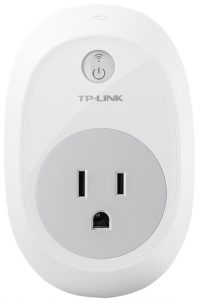 When we began looking for smart outlets to replace timers, we knew we needed devices that could remain plugged in and controllable by both pre-determined schedules as well as on-demand. The TP-Link Smart Wi-Fi Plugs fit our needs, had good reviews, a reasonable price, and connected directly to Wi-Fi. Instructions were very simple to get setup, and it requires a smart device application install of “Kasa by TP-Link.” The app offers scheduling and timer features for the outlet making the devices extremely versatile, not just for turning on and off ad hoc. Kasa by TP-Link also pairs nicely with voice-command devices, such as Amazon Echo, Google Home, etc. (reviewed above, under “Audio” subhead) to allow for voice control over the devices as well.
When we began looking for smart outlets to replace timers, we knew we needed devices that could remain plugged in and controllable by both pre-determined schedules as well as on-demand. The TP-Link Smart Wi-Fi Plugs fit our needs, had good reviews, a reasonable price, and connected directly to Wi-Fi. Instructions were very simple to get setup, and it requires a smart device application install of “Kasa by TP-Link.” The app offers scheduling and timer features for the outlet making the devices extremely versatile, not just for turning on and off ad hoc. Kasa by TP-Link also pairs nicely with voice-command devices, such as Amazon Echo, Google Home, etc. (reviewed above, under “Audio” subhead) to allow for voice control over the devices as well.
Of Note:
These are smart home devices we are aware of and fans of, based on media reports, but do not currently own or use.
- Philips Hue Smart Bulb
- Samsung SmartThings Outlet (or other outlets that utilize Z-Wave / Zigbee technology)
Phone
Ooma*
 Ooma was one of our earliest IoT devices, allowing for Voice over Internet Protocol (VoIP) phone service. It’s consistently ranked in a top spot in Consumer Reports home phone reviews. It has an initial upfront hardware cost, but beyond that, you only pay local, nominal phone line taxes. Ours, for instance, amount to $5.95 per month. Ooma comes standard with the ability to have two lines running through the singular device. It can tie into your currently wired phone outlets or be used with satellite / wireless handsets, including powered adapters that allow you to plug phone cords in anywhere there’s a standard electrical outlet. Both iOS and Android smart device applications are available to place phone calls and check voicemail. Ooma can easily pair with an array of applications and features to other IoT devices, including Amazon Alexa OS to make phone calls or listen to voicemail, blink smart lights (like Philips Hue) when incoming calls are coming in, Nest to forward calls when you’re not home and send alarm alerts, or Dropbox and Google for archiving voicemail to their cloud storage. There are also additional pay features, which you can review in the Basic vs. Premier pricing chart on the Ooma website. So far we love this device (mostly for the cost savings, but also so we still have a home phone). If we relocate homes at any point, the device and our numbers easily port with us. We believe this to be one of the best VoIP systems on the market and is very feature rich and highly recommended for anyone that still wants or needs a home line but at a fraction of what the cable and satellite bundled TV services offer for the service. If you want to take Ooma a step further, they now offer options for self-install home security monitoring or even as a firewall and site blocker for safer internet browsing over your home network. For more, see Cut the Cord: Alternative Solutions for Ditching Cable TV.
Ooma was one of our earliest IoT devices, allowing for Voice over Internet Protocol (VoIP) phone service. It’s consistently ranked in a top spot in Consumer Reports home phone reviews. It has an initial upfront hardware cost, but beyond that, you only pay local, nominal phone line taxes. Ours, for instance, amount to $5.95 per month. Ooma comes standard with the ability to have two lines running through the singular device. It can tie into your currently wired phone outlets or be used with satellite / wireless handsets, including powered adapters that allow you to plug phone cords in anywhere there’s a standard electrical outlet. Both iOS and Android smart device applications are available to place phone calls and check voicemail. Ooma can easily pair with an array of applications and features to other IoT devices, including Amazon Alexa OS to make phone calls or listen to voicemail, blink smart lights (like Philips Hue) when incoming calls are coming in, Nest to forward calls when you’re not home and send alarm alerts, or Dropbox and Google for archiving voicemail to their cloud storage. There are also additional pay features, which you can review in the Basic vs. Premier pricing chart on the Ooma website. So far we love this device (mostly for the cost savings, but also so we still have a home phone). If we relocate homes at any point, the device and our numbers easily port with us. We believe this to be one of the best VoIP systems on the market and is very feature rich and highly recommended for anyone that still wants or needs a home line but at a fraction of what the cable and satellite bundled TV services offer for the service. If you want to take Ooma a step further, they now offer options for self-install home security monitoring or even as a firewall and site blocker for safer internet browsing over your home network. For more, see Cut the Cord: Alternative Solutions for Ditching Cable TV.
*This referral link will get you a $20 Amazon.com Gift Card when you order an Ooma Telo from ooma.com. We also recommend checking out what deal you can score at your local Costco Wholesale.
TV
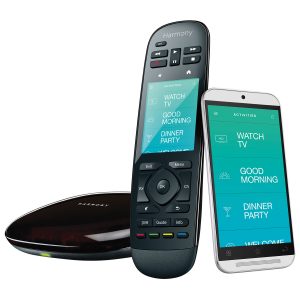 The Harmony remote communicates over the household Wi-Fi, with radio frequencies (RF), Bluetooth (BT), and infrared (IR) signals to a hub operated on the home network, which allows multiple device remote controls to be consolidated into just one. Additionally, operate your TV and devices via your smartphone, so when your child hides your primary remote, you still have access to your shows (so long as they didn’t hide your phone too). For more, see Cut the Cord: Alternative Solutions for Ditching Cable TV.
The Harmony remote communicates over the household Wi-Fi, with radio frequencies (RF), Bluetooth (BT), and infrared (IR) signals to a hub operated on the home network, which allows multiple device remote controls to be consolidated into just one. Additionally, operate your TV and devices via your smartphone, so when your child hides your primary remote, you still have access to your shows (so long as they didn’t hide your phone too). For more, see Cut the Cord: Alternative Solutions for Ditching Cable TV.
Safety & Security
Our particular regional security monitoring company includes use of the Alarm.com smart phone application with the monthly fee. This particular application is fairly basic, and we primarily use it to turn our alarm on and off after exiting and before entering the home. It’s just one button you have to push within the application. Works with any Wi-Fi enabled home security panel.
Nest Protect Smoke & Carbon Monoxide Alarm
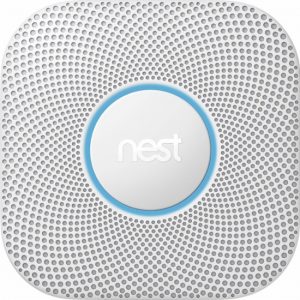 Just before our daughter was born, we replaced one of our six hard-wired smoke detectors (the one in the hallway on the bedroom floor) with a Nest Protect. This device gives us peace of mind about our home’s carbon monoxide levels, as well as smoke. Carbon monoxide is a silent killer and you desperately need a detector in your home if you have natural gas in use or garaged vehicles. When we relocate at some point in the next couple of years, we will consider installing these devices as primary detectors on all levels of the home. The Nest Protect has a built-in LED light ring indicator that visually alerts you to system and alarm status, as well as serving as a motion-activated night light. You can use this same motion sensor to trigger other home smart device events, like set the Nest Thermostat (reviewed above, under “Heating / Cooling” subhead) from “Away” to “Home” (if the devices are on two different levels of your home, for instance). If you’re feeling adventuresome, you can deploy the free IFTTT (If This Then Than That) service (reviewed below, under “Online Applications That Tie It All Together” subhead) to trigger other IoT devices or simply log events in a Google Drive Sheet.
Just before our daughter was born, we replaced one of our six hard-wired smoke detectors (the one in the hallway on the bedroom floor) with a Nest Protect. This device gives us peace of mind about our home’s carbon monoxide levels, as well as smoke. Carbon monoxide is a silent killer and you desperately need a detector in your home if you have natural gas in use or garaged vehicles. When we relocate at some point in the next couple of years, we will consider installing these devices as primary detectors on all levels of the home. The Nest Protect has a built-in LED light ring indicator that visually alerts you to system and alarm status, as well as serving as a motion-activated night light. You can use this same motion sensor to trigger other home smart device events, like set the Nest Thermostat (reviewed above, under “Heating / Cooling” subhead) from “Away” to “Home” (if the devices are on two different levels of your home, for instance). If you’re feeling adventuresome, you can deploy the free IFTTT (If This Then Than That) service (reviewed below, under “Online Applications That Tie It All Together” subhead) to trigger other IoT devices or simply log events in a Google Drive Sheet.
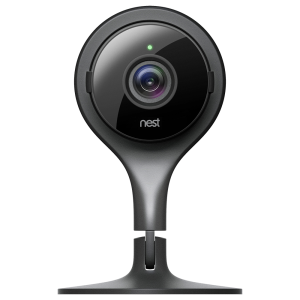 We have NestCams discretely installed inside and outside our home. NestCams are great if you need the motion- and audio-detection capabilities without the “doorbell” part that I’ll go over with the Ring Video Doorbell (reviewed next). You can also setup your account to have multiple viewers, so you could share the feed with grandparents who live at a distance to your newborn baby, for instance. Whatever you do, just please make sure you change the default password when you first setup the device. This will keep strangers from viewing your camera feed. If you do install a NestCam in a nursery, also please run the wiring through the wall to prevent little ones from pulling the cable(s) into a crib and risk strangulation.
We have NestCams discretely installed inside and outside our home. NestCams are great if you need the motion- and audio-detection capabilities without the “doorbell” part that I’ll go over with the Ring Video Doorbell (reviewed next). You can also setup your account to have multiple viewers, so you could share the feed with grandparents who live at a distance to your newborn baby, for instance. Whatever you do, just please make sure you change the default password when you first setup the device. This will keep strangers from viewing your camera feed. If you do install a NestCam in a nursery, also please run the wiring through the wall to prevent little ones from pulling the cable(s) into a crib and risk strangulation.
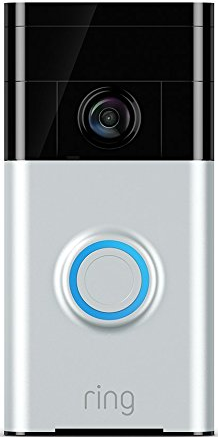 We purchased our Ring video doorbell online in early 2015 and connected it to our pre-wired doorbell connection at our front door. We especially loved its flat-rate price and full guarantee / warranty. We later opted into the $30/year (or $3/month) cloud storage and backup for the last 6 months of videos, so they are always available, though this is entirely optional. With a brand new Ring purchase, you’ll get a 30-day free trial of this to test it before you have to decide to opt into it or not. We also purchased two separate “plug-in” chime devices for our lowest level and upper level, where you can’t so easily hear the first-floor internal doorbell chime ring. This little device has been one of our favorite purchases to-date. Not only does it show who’s ringing our doorbell to our smart phone, whether we’re currently inside the home, at work, or on vacation, but it allows you correspond with the individual and ask them to come back later. It also has motion detection, which is really great to track vehicles and foot traffic in our neighborhood that perhaps shouldn’t be there. In the past year, they introduced “Live View,” which lets us check-in occasionally and make sure that our package deliveries are still sitting where they should be on our front porch. All of this with great nightvision too. In the case where there’s a solicitor or crime, that you’d like to broadcast to the neighborhood, you can share selected videos with others who have a Ring device and reside within a certain proximity to your home. We have had a couple of minor issues with the construction of the Ring, but the company has quickly and painlessly replaced the device for free regardless of the issue we’ve had. They also guarantee that it’s theft-proof, since the goal is to catch any perpetrators on video before they would tamper with the device anyway. This short video on YouTube will go more in depth over the benefits of the Ring doorbell. Our local Costco Wholesale sells the Ring device along with a chime (just as helpful for the person who doesn’t currently have a hardwired interior doorbell chime as it is in our multi-level use situation), so check yours for the best deal first.
We purchased our Ring video doorbell online in early 2015 and connected it to our pre-wired doorbell connection at our front door. We especially loved its flat-rate price and full guarantee / warranty. We later opted into the $30/year (or $3/month) cloud storage and backup for the last 6 months of videos, so they are always available, though this is entirely optional. With a brand new Ring purchase, you’ll get a 30-day free trial of this to test it before you have to decide to opt into it or not. We also purchased two separate “plug-in” chime devices for our lowest level and upper level, where you can’t so easily hear the first-floor internal doorbell chime ring. This little device has been one of our favorite purchases to-date. Not only does it show who’s ringing our doorbell to our smart phone, whether we’re currently inside the home, at work, or on vacation, but it allows you correspond with the individual and ask them to come back later. It also has motion detection, which is really great to track vehicles and foot traffic in our neighborhood that perhaps shouldn’t be there. In the past year, they introduced “Live View,” which lets us check-in occasionally and make sure that our package deliveries are still sitting where they should be on our front porch. All of this with great nightvision too. In the case where there’s a solicitor or crime, that you’d like to broadcast to the neighborhood, you can share selected videos with others who have a Ring device and reside within a certain proximity to your home. We have had a couple of minor issues with the construction of the Ring, but the company has quickly and painlessly replaced the device for free regardless of the issue we’ve had. They also guarantee that it’s theft-proof, since the goal is to catch any perpetrators on video before they would tamper with the device anyway. This short video on YouTube will go more in depth over the benefits of the Ring doorbell. Our local Costco Wholesale sells the Ring device along with a chime (just as helpful for the person who doesn’t currently have a hardwired interior doorbell chime as it is in our multi-level use situation), so check yours for the best deal first.
Ring Video Doorbell Introduces “Neighbors” App
In early 2018, Ring opened up its Neighbors smart device app to anyone regardless if they have a Ring video door bell installed or not. You may want to consider this before you take the jump into your first Ring product. Why? Because simply trying out the app (this link, new subscribers only), will get $10 in Ring Credit that you can turn around and put towards your device purchase. The app allows you to be in the know on neighborhood concerns. Read the full Neighbors app review on Engadget.
Samsung SmartThings (Z-Wave and Zigbee Hub)
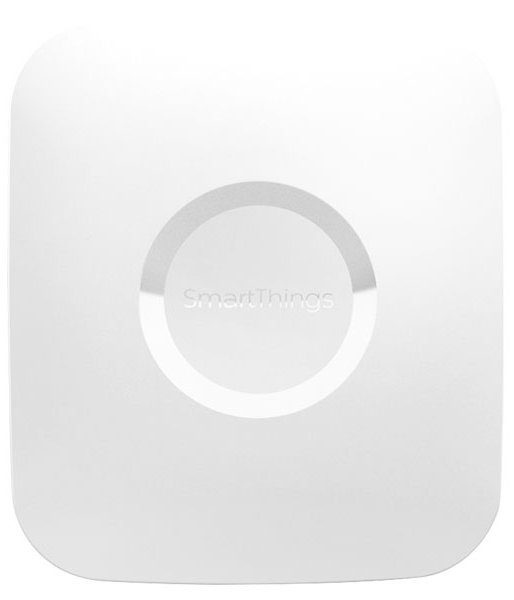 You can’t get into home automation and monitoring without looking at or getting a Z-Wave or Zigbee device. There are many out there that allow for monitoring and remote control of many devices; door locks, home monitoring sensors, garage door control, outlets, cameras, water shut-off valves, lights … the list goes on and on. These two technologies are king of the home automation world and very customizable: allowing those with some technical know-how to create their own devices and sensors. We recently purchased and installed a Yale Push-Button Electronic Deadbolt with Z-Wave* (comes in Nickel, Bronze, or Brass) from discount site Yugster (discount no longer available). This device allows you to check if your deadbolt is locked remotely, and unlock and lock on-demand. These devices do not work out-of-the-box without a home-to-device bridging communication hub. That is where the Samsung SmartThings hub comes into play. The reviews, as well as the community-sourced support available, made the Samsung SmartThings hub seem like the smart choice. It works with both Z-Wave and Zigbee devices (note: there are some hubs that are just one of the other). The SmartThings hub is also able to interface with your favorite home assistant platform of choice (reviewed above, under “Audio” subhead) allowing for voice commands to pull status and change states (like “Computer, unlock the door”). Additional features can be implemented using the IFTTT (If This Then That) (reviewed below, under “Online Applications That Tie It All Together” subhead) framework of macros that can be created to trigger all type of events. Since this was a relatively new install for us, we’re primarily and simply enjoying deadbolt status.
You can’t get into home automation and monitoring without looking at or getting a Z-Wave or Zigbee device. There are many out there that allow for monitoring and remote control of many devices; door locks, home monitoring sensors, garage door control, outlets, cameras, water shut-off valves, lights … the list goes on and on. These two technologies are king of the home automation world and very customizable: allowing those with some technical know-how to create their own devices and sensors. We recently purchased and installed a Yale Push-Button Electronic Deadbolt with Z-Wave* (comes in Nickel, Bronze, or Brass) from discount site Yugster (discount no longer available). This device allows you to check if your deadbolt is locked remotely, and unlock and lock on-demand. These devices do not work out-of-the-box without a home-to-device bridging communication hub. That is where the Samsung SmartThings hub comes into play. The reviews, as well as the community-sourced support available, made the Samsung SmartThings hub seem like the smart choice. It works with both Z-Wave and Zigbee devices (note: there are some hubs that are just one of the other). The SmartThings hub is also able to interface with your favorite home assistant platform of choice (reviewed above, under “Audio” subhead) allowing for voice commands to pull status and change states (like “Computer, unlock the door”). Additional features can be implemented using the IFTTT (If This Then That) (reviewed below, under “Online Applications That Tie It All Together” subhead) framework of macros that can be created to trigger all type of events. Since this was a relatively new install for us, we’re primarily and simply enjoying deadbolt status.
*The Yale Push-Button Electronic Deadbolt with Z-Wave has a turn-style knob inside the home. For a deadbolt to be most effective, make sure it’s installed far away from any glass panels in or near the door. When installing a deadbolt in or near a glass door or panel, the interior should be key-style. Turn-style are way too easy for would-be-thieves to turn with their hand when puncturing the glass closest to the deadbolt. Additionally, you will want to invest in a Box Strike Plate, generally around $10.
Of Note:
These are smart home devices we are aware of and fans of, based on media reports, but do not currently own or use.
- Arlo (there may also be a bundle deal available at your local Costco Wholesale)
- August Doorbell Cam in conjunction with the August Smart Lock allow you to see and communicate with those at your door as well as lock and unlock your door on-demand (there may still be a promotion running through the Ibotta smartphone rewards app, there was at the time of this post)
- Chamberlain Smart Garage Hub
- Ooma Home Security Starter Kit
- SimpliSafe Wireless Home Security System
Related:
- Elegant “No Soliciting” Sign
- Did You Know? Many local law enforcement departments offer complimentary canvasing of your home’s exterior to make recommendations on where to improve security. Check with yours to see what they may offer. They will look at your home with expert & outsider eyes.
Yard / Gardening
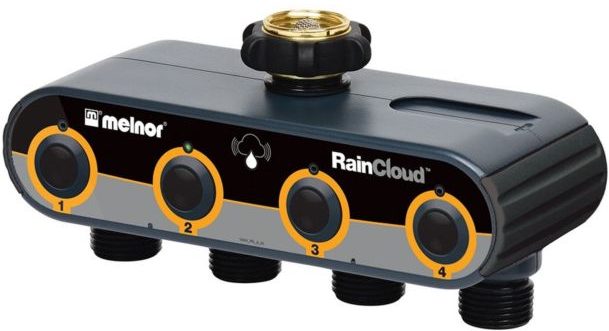 This internet-controlled irrigation valve device is great for watering your yard and garden where you don’t have an underground irrigation system established and when you want to water on a regular basis without much effort. Each night, we have the system set to go off while we’re sleeping. When rain is in the forecast, we can pause the schedule until we need it again. In the grand scheme of things, we’ve already come out ahead financially by using this device versus paying neighborhood kids that were not watering long enough or consistently during our vacations. This device is Amazon Alexa OS compatible.
This internet-controlled irrigation valve device is great for watering your yard and garden where you don’t have an underground irrigation system established and when you want to water on a regular basis without much effort. Each night, we have the system set to go off while we’re sleeping. When rain is in the forecast, we can pause the schedule until we need it again. In the grand scheme of things, we’ve already come out ahead financially by using this device versus paying neighborhood kids that were not watering long enough or consistently during our vacations. This device is Amazon Alexa OS compatible.
Online Applications That Tie It All Together
IFTTT (IF This Then Than That)
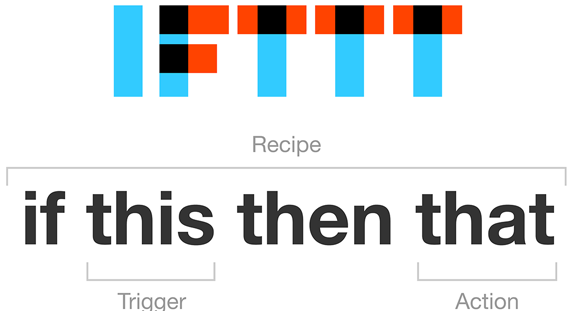 We have mentions of this free, online service a couple of times throughout this post. IFTTT is best described as a custom applet / macro framework to allow you to connect many different IoT devices and allow them to cross-communicate or trigger specific events. It can take a little getting use to but once you have your applets configured they can do anything from: “when motion is sensed by a camera or some device” = log event in a Google Drive Sheet stored / accessible in the cloud, change temperature, trigger an alert … you name it. It has even more features that extend outside of the IoT devices and apps, like social media and weather-based needs. We highly recommend you check out the site, with its often pre-created recipes.
We have mentions of this free, online service a couple of times throughout this post. IFTTT is best described as a custom applet / macro framework to allow you to connect many different IoT devices and allow them to cross-communicate or trigger specific events. It can take a little getting use to but once you have your applets configured they can do anything from: “when motion is sensed by a camera or some device” = log event in a Google Drive Sheet stored / accessible in the cloud, change temperature, trigger an alert … you name it. It has even more features that extend outside of the IoT devices and apps, like social media and weather-based needs. We highly recommend you check out the site, with its often pre-created recipes.
Social Follow and Share
New on the blog: My Favorite Smart Home / Small Business Devices https://t.co/wAcse1vSHx #smarthome #IoT #ringdoorbell #saveenergy pic.twitter.com/W8p7fKb9Bv
— Saving Amy (@savingamyblog) September 1, 2017
Disclaimers
We paid our own money for all of the products within this post, in order to provide unbiased reviews of our own accord. We did not receive any discount in exchange for any review.
Note: Affiliate off-site links are used in order to help support this blog site.
Saving Amy is a participant in the Amazon Services LLC Associates Program, an affiliate advertising program designed to provide a means for sites to earn advertising fees by advertising and linking to amazon.com.
Related:

